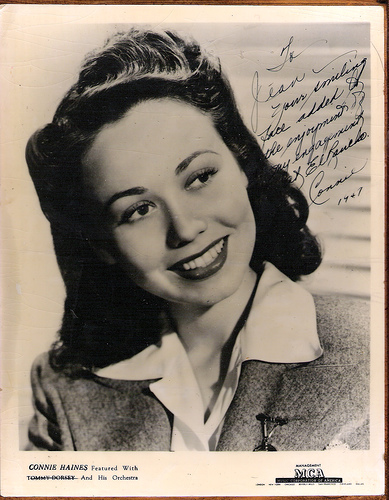Home » Jazz Musicians » Connie Haines
Connie Haines
Born Yvonne Jasme, big band vocalist Connie Haines began singing and dancing at an early age. Her big break came in 1935, at age 13, when she won an amateur contest on Fred Allen's NBC radio program. During the late 1930s she worked for Howard Lally's orchestra.
In 1939 bandleader Harry James heard Haines rehearsing at a New York music publishing company and hired her for his band, changing her name. She left the following year and kept busy with solo engagements around the New York area before being hired by Tommy Dorsey, where she joined former James bandmate Frank Sinatra.
In 1941 Haines landed the spot as featured vocalist on Abbott and Costello's radio program. She spent four years with the show. Haines has continued performing up to this day.
Haines made 200 recordings, including 24 records that sold more than 50,000 copies; regularly filled up prestigious nightclubs like the Latin Quarter in New York; and performed five times at the White House. Polls in music magazines in the 1940s rated her as one of the top female band singers.
 While Sinatra specialized at the time in ballads and slow foxtrots, Haines threw herself into rhythmic up-tempo tunes. “Where did you learn to swing like that?” Dorsey asked when he first heard her at a club in New Jersey. “And when can you join my band?”
While Sinatra specialized at the time in ballads and slow foxtrots, Haines threw herself into rhythmic up-tempo tunes. “Where did you learn to swing like that?” Dorsey asked when he first heard her at a club in New Jersey. “And when can you join my band?”
Her recordings including gospel, pop and soul, as well as big-band barnburners. The best-selling ones included “You Might Have Belonged to Another”; “Oh! Look at Me Now”; “What Is This Thing Called Love?”; and “Will You Still Be Mine?” A crowd favorite was “Snootie Little Cutie,” which often elicited ad libs from Sinatra.
She made the most of her sultry Southern accent, sometimes to Sinatra’s amusement. In her personalized rendition of “Let’s Get Away From It All,” she improvised, “We’ll spend a weekend in Dixie. I’ll get a real Southern drawl.” Sinatra piped in, “Another one?”
Miss Haines appeared on the radio with Abbott & Costello, Bing Crosby, Bob Hope and Jack Benny, among others. On television she appeared with Milton Berle, Ed Sullivan, Eddie Cantor and Perry Como. Her work on Frankie Laine’s variety show drew particular note. Her movies included her favorite, “Duchess of Idaho” (1950), with Esther Williams and Van Johnson.
Yvonne Marie Antoinette JaMais was born on Jan. 20, 1921, in Savannah, Ga., but grew up in Florida. Her mother, who taught voice and dance, pushed her talented daughter to excel. At 4, Yvonne appeared at the Bijou Theater in Savannah in a “Saucy Baby” show. At 5, Baby Yvonne Marie won state contests in the Charleston dance in Georgia and Florida.
Read moreTags
Connie Haines Dies Big Band Singer Co-Starred with Sinatra

Source:
Michael Ricci
Connie Haines, a petite and dynamic big band singer who performed alongside Frank Sinatra in the Harry James and Tommy Dorsey orchestras
Haines died Monday in Clearwater, Fla. The cause of death was myasthenia gravis, an autoimmune neuromuscular disease. She was 87.
Haines was best known as a singer with a knack for rhythm, and many of her most successful recordings -- 25 of which each sold more than 50,000 copies -- featured her crisp, swinging vocal style. When Dorsey ...
read more
Connie Haines: Peppy Singer Dies at 87

Source:
Michael Ricci
Connie Haines, a peppy, petite, big-voiced singer with a zippy, rhythmic style who most famously teamed up with Frank Sinatra as lead vocalists with the Tommy Dorsey Orchestra
Haines then went on to a prolific career of her own, died on Monday in Clearwater Beach, Fla. She was 87. The cause was myasthenia gravis, a neuromuscular disease, said Roseanne Young, a friend.
Miss Haines made 200 recordings, including 24 records that sold more than 50,000 copies; regularly filled up prestigious ...
read more



















